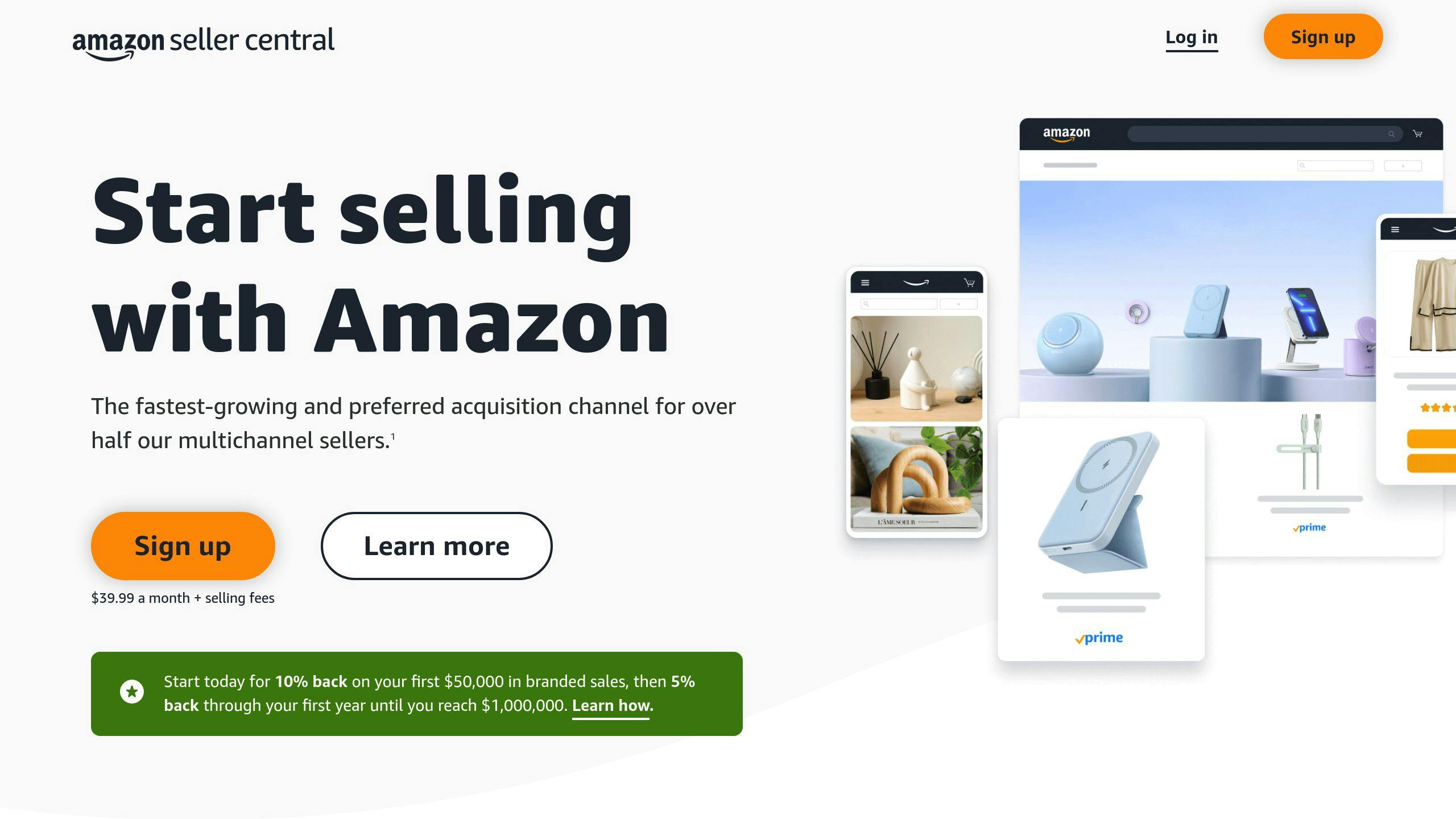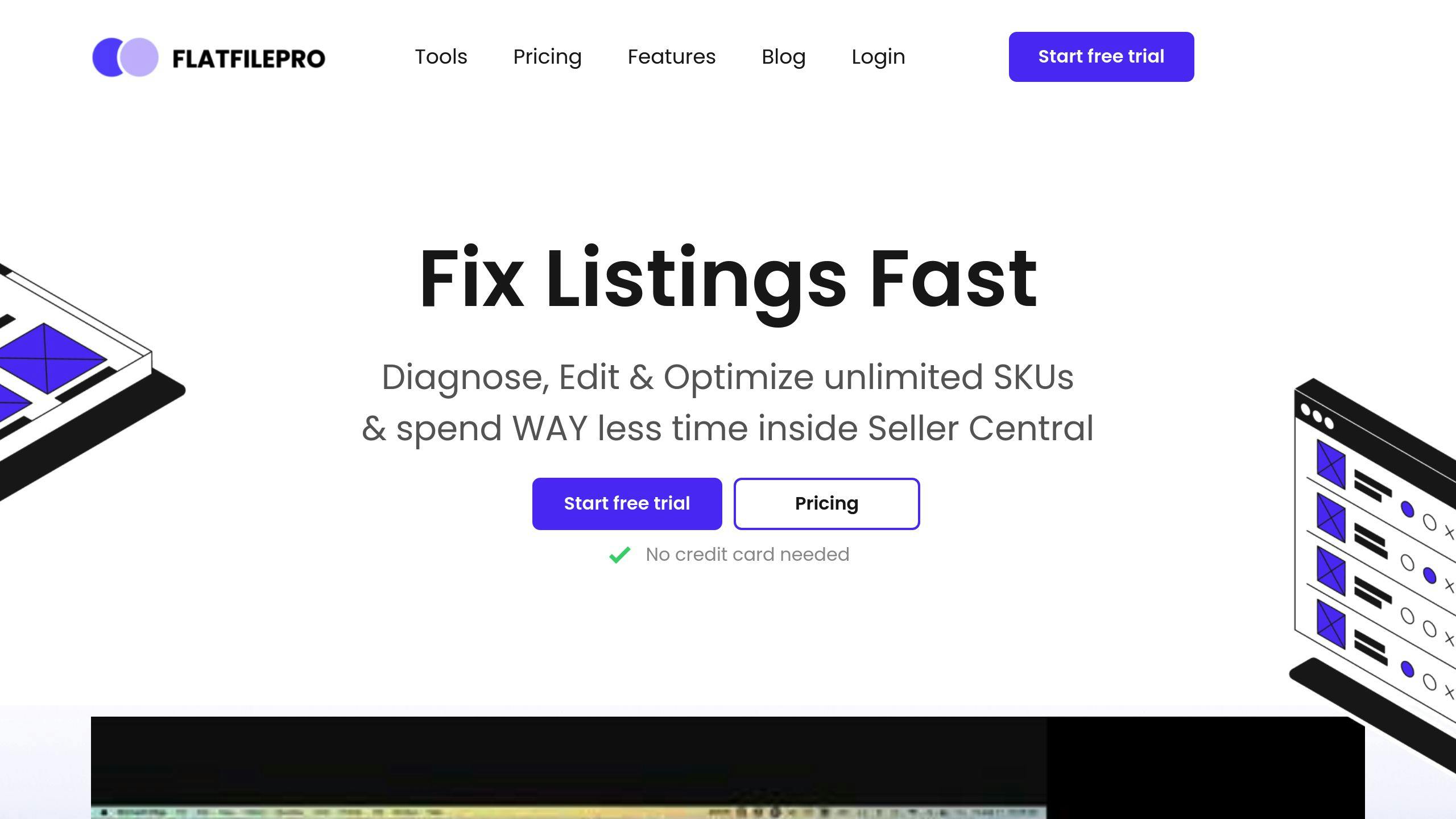Expanding your Amazon business internationally can unlock access to millions of new customers across 20+ marketplaces like Germany, Japan, and the UK. However, success requires more than just listing your products – it involves localizing your listings, complying with regional regulations, and choosing the right fulfillment method. Here’s what you need to know:
- Localization: Tailor product titles, descriptions, and images to fit local preferences and languages.
- Compliance: Meet local regulations (e.g., VAT in Europe, labeling laws in Japan).
- Fulfillment Options: Choose between FBA, FBM, or Pan-European FBA depending on your needs.
- Tools to Simplify Expansion: Use Amazon’s Build International Listings (BIL) tool for automated translations, price synchronization, and centralized management.
Quick Overview of Key Tools and Steps:
| Step | Details |
|---|---|
| Set Up Accounts | Register for regional marketplaces (e.g., VAT for Europe, EORI for the UK). |
| Localization | Use accurate translations and adapt to local shopping habits. |
| Fulfillment | Choose FBA for simplicity or FBM for control. |
| Catalog Management | Use tools like Amazon Seller Central and FlatFilePro for bulk updates and error reduction. |
By combining localization, compliance, and smart tools, you can grow your Amazon business globally while minimizing risks and maximizing sales potential.
Understanding International Amazon Listings
1: What Are International Amazon Listings?
International Amazon listings are product entries tailored for selling in marketplaces outside your home country. They differ from domestic listings in several important ways:
| Aspect | Requirements | Impact |
|---|---|---|
| Language | Accurate translations | Helps customers understand products clearly |
| Cultural Elements | Align with local preferences and customs | Creates stronger connections with shoppers |
| Compliance | Meet regional regulations | Ensures legal alignment |
| Product Details | Match market-specific needs | Sets accurate customer expectations |
For instance, in Japan, listings must follow strict labeling laws, use the metric system, and reflect local shopping habits. Product descriptions should also respect cultural norms to resonate with buyers.
Now that we’ve covered the basics, let’s take a look at how Amazon’s Global Selling Program simplifies this process.
2: Overview of Amazon’s Global Selling Program
Amazon’s Global Selling Program is designed to help sellers expand internationally with ease. At the heart of the program is the Build International Listings (BIL) tool, which offers several useful features:
- Automated translations for listings across different marketplaces
- Price synchronization based on current exchange rates
- Centralized management for inventory and compliance
One standout feature is the automatic price synchronization. When you update prices in one marketplace, the tool adjusts prices in others automatically, factoring in exchange rates and predefined rules.
The BIL tool also tracks currency changes, ensures consistent pricing, and allows for bulk updates. This not only saves time and minimizes errors but also helps sellers stay compliant across regions.
Steps for Creating and Managing International Listings
1: Setting Up Accounts and Registering for Marketplaces
Getting started with Amazon’s global marketplaces requires careful preparation. The first step is to create either a unified account or region-specific accounts through Amazon Seller Central.
| Region | Requirements |
|---|---|
| Europe | VAT Registration, EORI Number, Fiscal Representative |
| Japan | Japanese Business License, Local Bank Account |
| UK | Company Registration, GB EORI Number |
For example, selling in Germany involves submitting detailed business information, tax documents, and ensuring your payment methods align with EU standards. Once your accounts are ready, the focus shifts to crafting product listings that resonate with local shoppers.
2: Localizing Listings for Different Markets
Localization goes beyond simple translation – it’s about adapting your listings to suit local preferences and expectations. Each marketplace requires a tailored approach to connect with customers effectively.
| Market | Key Localization Elements | Cultural Considerations |
|---|---|---|
| Germany | Detailed Technical Specs | Direct Communication Style |
| Japan | Package Dimensions | Gift-Wrapping Options |
| UK | British English Terms | Local Size Charts |
While Amazon’s Build International Listings (BIL) tool can handle basic translations, many successful sellers also use human translation services to ensure accuracy and cultural relevance.
"Improving your Amazon ranking is all about enhancing your product listing’s appeal and visibility." [1]
Once your listings are localized, the next step is to decide on the best way to fulfill orders and meet customer expectations.
3: Choosing Fulfillment Options
Localization doesn’t stop at product descriptions – it also applies to how you deliver products to customers. There are several fulfillment options to consider:
Fulfillment by Amazon (FBA)
- Simplifies logistics but comes with higher fees
- Makes your products eligible for Prime shipping
Fulfillment by Merchant (FBM)
- Gives you control over shipping but requires a reliable network
- Ideal for items needing special handling or seasonal products
Pan-European FBA
- Enables fast delivery across the EU with VAT registration
- Allows you to store inventory in one location
The right fulfillment method depends on your products, target markets, and operational setup. For example, Pan-European FBA is great for sellers with steady EU demand, while FBM is better for products that need specific handling.
How to Sell Globally on Amazon
sbb-itb-ed4fa17
Tools and Strategies for Managing International Catalogs
Handling international catalogs demands precision and efficiency to cater to the diverse needs of global marketplaces. Here’s how to make the most of key tools and strategies.
1: Using Amazon Seller Central for Bulk Updates
Amazon Seller Central simplifies bulk updates with features that help manage inventory, adjust pricing across currencies, and maintain listing quality with built-in validation checks. It offers:
| Feature | Benefit |
|---|---|
| Cross-marketplace Management | Manage multiple regions from one platform |
| Automated Validation | Catch and fix common listing errors automatically |
| Inventory Tracking | Keep stock levels balanced across regions |
These tools are especially useful during high-demand seasons, such as coordinating inventory for the holiday rush across various international markets.
2: Using FlatFilePro for Advanced Catalog Management
For sellers with more complex needs, FlatFilePro provides enhanced catalog management capabilities tailored for international operations:
| Feature | Benefit |
|---|---|
| Advanced Bulk Editing | Simplify updates for large numbers of SKUs |
| Error Recovery | Quickly spot and fix listing issues |
| Variation Management | Easily organize product variations across regions |
FlatFilePro also includes real-time tracking tools, making it easier to monitor changes and resolve errors as they arise.
"Effective catalog management is crucial for improving product visibility and sales in international markets." – Will Mitchell, E-commerce Expert, StartupBros [1]
3: Best Practices for Automation and Error Reduction
To maintain quality and efficiency, sellers should adopt systematic approaches for catalog management:
Data Validation Protocols
- Use standardized templates for each marketplace.
- Apply consistent formatting rules.
- Conduct routine quality checks.
Update Framework
| Stage | Action | Purpose |
|---|---|---|
| Pre-upload | Verify templates | Avoid formatting errors |
| Post-upload | Confirm listings | Ensure accurate deployment |
| Regular review | Analyze performance | Improve listing effectiveness |
Automated tools for catalog management can significantly boost operational efficiency, especially when dealing with complex international listings. By combining these tools and strategies, sellers can better tailor their offerings to meet the unique needs of each market.
Best Practices for Success in International Markets
Building on the tools and strategies mentioned earlier, these practices can help your listings thrive in various international markets.
1: Localizing Product Titles, Descriptions, and Images
Localization goes beyond simple translation. It involves tailoring your listings to align with local buyer preferences, which can boost both conversion rates and customer satisfaction, as shown by Amazon data.
| Localization Element | Best Practice | Impact |
|---|---|---|
| Product Titles | Include market-specific keywords | Boosts search visibility |
| Descriptions | Adjust for cultural preferences | Builds buyer trust |
| Images | Align with local visual norms | Improves conversion rates |
For example, German shoppers may prefer detailed technical specs, while Japanese buyers might respond better to lifestyle-focused imagery.
2: Ensuring Compliance with Regional Regulations
Every region has its own set of rules and certifications. To avoid potential issues, ensure your products meet standards like CE marking in the EU or PSE certification in Japan. Also, pay attention to local labeling requirements, such as measurement systems, safety warnings, and material disclosures.
Once your listings meet these standards, focus on keeping them optimized to stay competitive in the market.
3: Monitoring and Optimizing Listing Performance
Success in international markets requires constant monitoring and fine-tuning. Amazon’s A9 algorithm evaluates market-specific factors when ranking products, so staying on top of performance is crucial.
| Metric | Monitoring Frequency | Action Items |
|---|---|---|
| Conversion Rate | Weekly | Adjust pricing or update content |
| Search Ranking | Bi-weekly | Refine keywords and images |
| Customer Reviews | Daily | Respond to feedback and update FAQs |
Use Amazon Brand Analytics to find high-performing keywords and refine your listings to match local search behaviors.
Price Optimization: Amazon’s Automate Pricing tool can help you stay competitive. When adjusting prices, consider:
- Local market trends
- Shipping costs
- Currency exchange rates
- Competitor pricing in the region
Regularly reviewing and tweaking your listings based on data ensures they remain effective and relevant in each market. A data-driven approach will help you maintain a competitive edge across all international marketplaces.
Conclusion: Achieving Success with International Amazon Listings
Expanding your reach on Amazon’s global marketplaces requires a focus on localization, staying compliant with regulations, and managing your catalog effectively. By combining an understanding of local market needs with the right tools, sellers can keep their listings consistent while tailoring them to regional preferences.
Essential Tools and Strategies
Managing international listings effectively calls for advanced catalog management and analytics tools. Platforms like FlatFilePro and Amazon Brand Analytics help sellers oversee listings across multiple marketplaces, monitor performance, and fine-tune for local audiences. These tools play a key role in handling localization, verifying compliance, and keeping track of performance metrics.
Keys to Long-Term Growth
Thriving in international markets hinges on three main principles: keeping a close eye on performance metrics, quickly responding to market shifts and regulatory updates, and leveraging automation to simplify processes. Regularly reviewing data can uncover areas for improvement, while automation tools help streamline operations across various regions.



